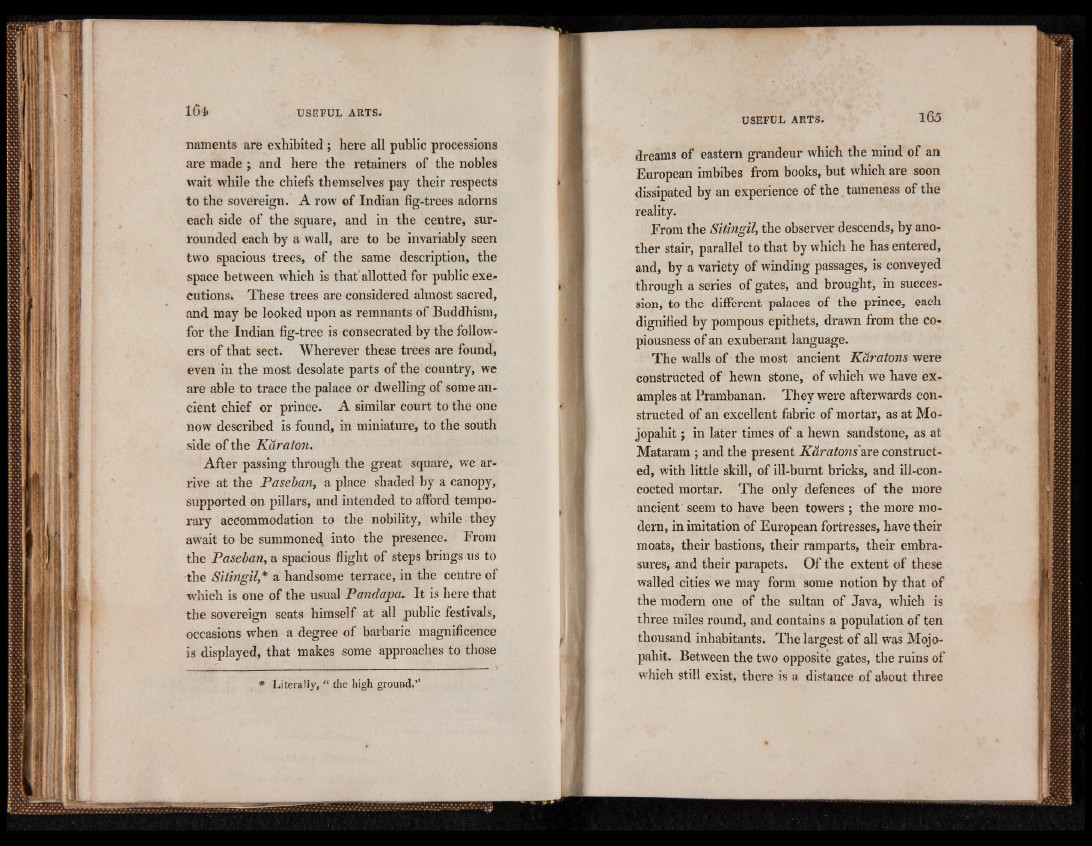
naments are exhibited ; here all public processions
are made ; and here the retainers of the nobles
wait while the chiefs themselves pay their respects
to the sovereign. A row of Indian fig-trees adorns
each side of the square, and in the centre, surrounded
each by a wall, are to be invariably seen
two spacious trees, of the same description, the
space between which is that' allotted for public executions.
These trees are considered almost sacred,
and may be looked upon as remnants of Buddhism,
for the Indian fig-tree is consecrated by the followers
of that sect. Wherever these trees are found,
even in the most desolate parts of the country, we
are able to trace the palace or dwelling of some ancient
chief or prince. A similar court to the one
now described is found, in miniature, to the south
side of the Kdraton.
After passing through the great square, we arrive
at the Paseban, a place shaded by a canopy,
supported on pillars, and intended to afford temporary
accommodation to the nobility, while they
await to be summoned into the presence. From
the Paseban, a spacious flight of steps brings us to
the Sitingil,* a handsome terrace, in the centre of
which is one of the usual Pandapa. It is here that
the sovereign seats himself at all public festivals,
occasions when a degree of barbaric magnificence
is displayed, that makes some approaches to those
* Literally, “ the high ground.”
dreams of eastern grandeur which the mind of an
European imbibes from books, but which are soon
dissipated by an experience of the tameness of the
reality.
From the Sitingil, the observer descends, by another
stair, parallel to that by which he has entered,
and, by a variety of winding passages, is conveyed
through a series of gates, and brought, in succession,
to the different palaces of the prince, each
dignified by pompous epithets, drawn from the copiousness
of an exuberant language.
The walls of the most ancient Kdratons were
constructed of hewn stone, of which we have examples
at Prambanan. They were afterwards constructed
of an excellent fabric of mortar, as at Mo-
jopahit; in later times of a hewn sandstone, as at
Mataram ; and the present Kdratons &re constructed,
with little skill, of ill-burnt bricks, and ill-concocted
mortar. The only defences of the more
ancient seem to have been towers ; the more modern,
in imitation of European fortresses, have their
moats, their bastions, their ramparts, their embrasures,
and their parapets. Of the extent of these
walled cities we may form some notion by that of
the modern one of the sultan of Java, which is
three miles round, and contains a population of ten
thousand inhabitants. The largest of all was Mojo-
pahit. Between the two opposite gates, the ruins of
which still exist, there is a distance of about three